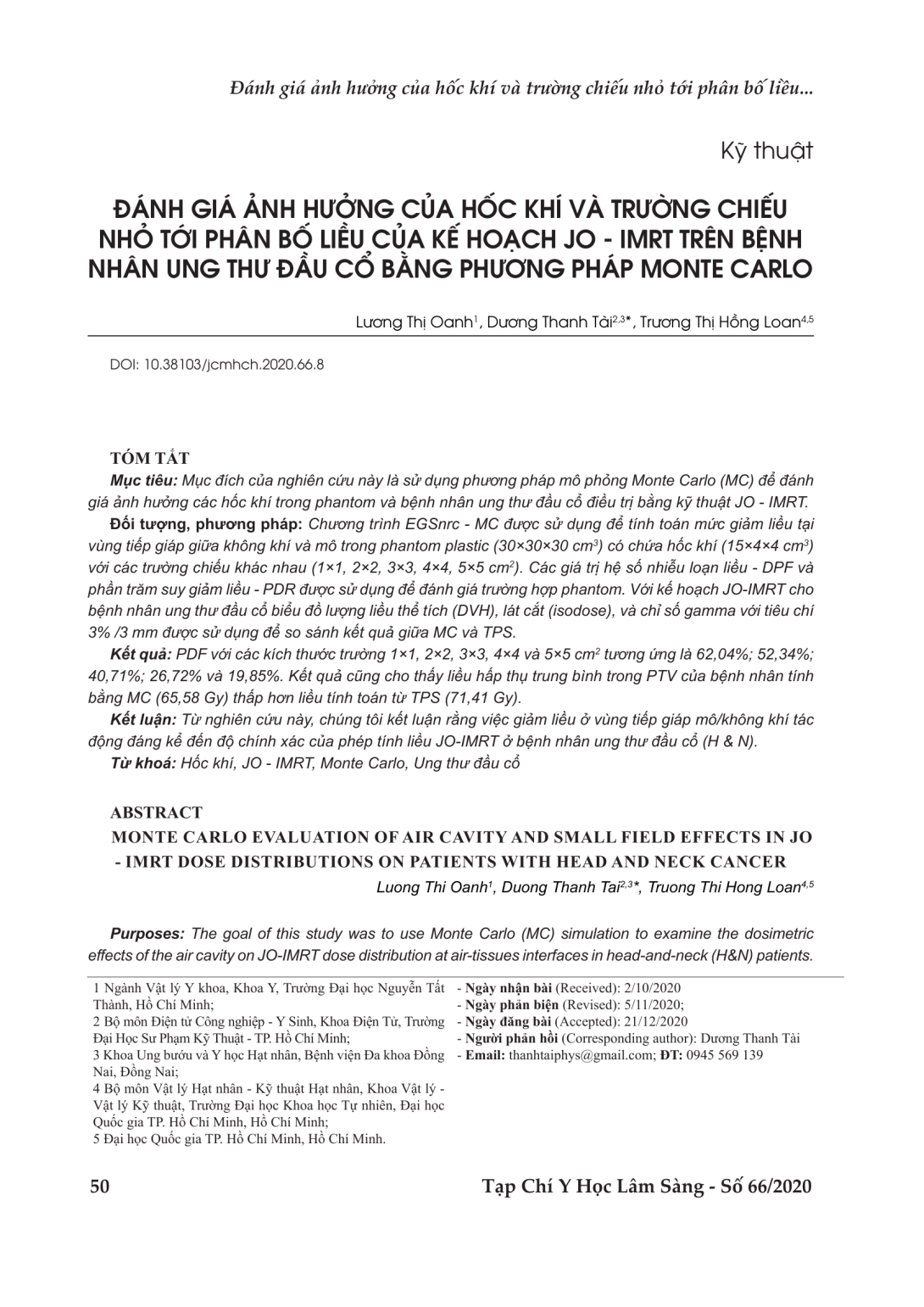
Mục đích của nghiên cứu này là sử dụng phương pháp mô phỏng Monte Carlo (MC) để đánh giá ảnh hưởng các hốc khí trong phantom và bệnh nhân ung thư đầu cổ điều trị bằng kỹ thuật JO - IMRT. Chương trình EGSnrc - MC được sử dụng để tính toán mức giảm liều tại vùng tiếp giáp giữa không khí và mô trong phantom plastic (30×30×30 cm3) có chứa hốc khí (15×4×4 cm3) với các trường chiếu khác nhau (1×1, 2×2, 3×3, 4×4, 5×5 cm2). Các giá trị hệ số nhiễu loạn liều - DPF và phần trăm suy giảm liều - PDR được sử dụng để đánh giá trường hợp phantom. Với kế hoạch JO-IMRT cho bệnh nhân ung thư đầu cổ biểu đồ lượng liều thể tích (DVH), lát cắt (isodose), và chỉ số gamma với tiêu chí 3% /3 mm được sử dụng để so sánh kết quả giữa MC và TPS. Kết quả PDF với các kích thước trường 1×1, 2×2, 3×3, 4×4 và 5×5 cm2 tương ứng là 62,04%; 52,34%; 40,71%; 26,72% và 19,85%. Kết quả cũng cho thấy liều hấp thụ trung bình trong PTV của bệnh nhân tính bằng MC (65,58 Gy) thấp hơn liều tính toán từ TPS (71,41 Gy). Kết luận Từ nghiên cứu này, chúng tôi kết luận rằng việc giảm liều ở vùng tiếp giáp mô/không khí tác động đáng kể đến độ chính xác của phép tính liều JO-IMRT ở bệnh nhân ung thư đầu cổ (H & N).
The goal of this study was to use Monte Carlo (MC) simulation to examine the dosimetric effects of the air cavity on JO-IMRT dose distribution at air-tissues interfaces in head-and-neck (H&N) patients The EGSnrc - MC code system was used to calculate the dose reductions in air-tissue interface region for single field irradiations with 1×1, 2×2, 3×3, 4×4, and 5×5 cm2 in solid acrylic phantoms (30×30×20 cm3) and seven fields in a JO-IMRT plan. With phantom, the PDD values in both with and without an air cavity (15×4×4 cm3) which is 2.5 cm away from the anterior surface of phantom were used to evaluate. With the JO-IMRT plan, the dose-volume histograms (DVH), slice by slice isodose, and the gamma index using global methods implemented in PTW-VeriSoft with 3%/3 mm criteria were used to evaluate. Results The study results indicate that the dose reductions in the air-tissue interface region of the phantom are strongly dependent on field size. The average percentage dose reductions at 1 mm from the air‑water interface for the field size 1×1, 2×2, 3×3, 4×4, and 5×5 cm2 are 62.04%, 52.34%, 40.71%, 26.72%, and 19.85%, respectively. Additionally, the mean MC dose in the PTV (65.58 Gy) of patients were lower than the TPS predicted dose (71.41 Gy). Conclusions From this study, we conclude that the dose reduction in near air-tissue interfaces is a significant effect on JO-IMRT dose distribution in head-and-neck (H&N) patients.
- Đăng nhập để gửi ý kiến
